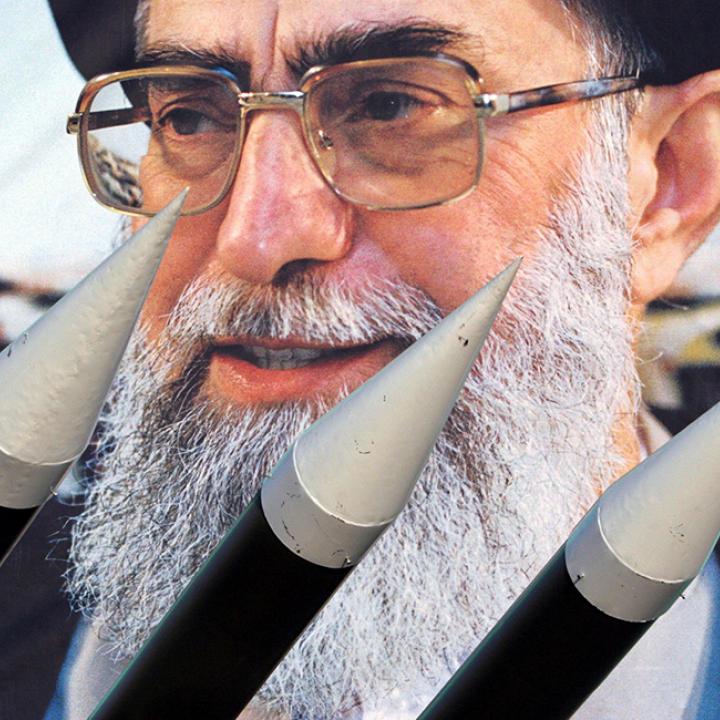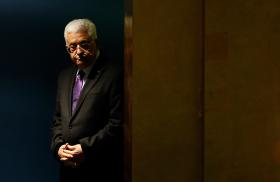
- Policy Analysis
- Fikra Forum
Ayatollah Khamenei: Shifting from Velayat-e Faqih to Military Control

Almost forty years after its inception, the project of the Islamic Republic has failed. Ayatollah Khamenei has in essence admitted that an Islamic state is not complete in Iran. Nor is Iranian society unequivocally Islamic in the manner that the revolution intended: rather the Iranian government merely follows and applies Islamic rules onto society. With the re-imposition of international and local embargos and sanctions on Iran, the goal of the Islamic Republic has now shifted from expansionism to protecting Iranian national interests as the country enters its weakest period in recent memory. Along with building international pressures, the Iranian regime increasingly lacks the support of its own people. If economic sanctions continue against the population of Iran, the country may eventually experience a revolution driven by the need for basic goods and services.
Major protests in a number of cities and regions have already led the government to re-evaluate its political strategy: while the government can limit the protests’ growth to some extent through religious prescriptions and by force, it cannot stop the movement entirely. In the meantime, the protests’ rhetoric is directly targeting the country’s political system and leadership, focusing on systemic corruption. The protests are decentralized, and the speeches given during the demonstrations are directed at the political system and the leader of the country, not outside forces. The root of the crisis in Iran is historical, stemming from systematic corruption. While U.S. sanctions have acted as a catalyst, they have merely helped bring to the surface the regime’s deep strategic crisis. The Islamic regime, with its reliance on ideology, its mismanagement of funds, and its establishment of parallel governments, has created this type of instability.
The fact that Ayatollah Khamenei is approaching the end of his natural lifespan also suggests that these protests are heralding the beginning of an end of an era. In Iranian history, it is hard to imagine a political figure who has more closely intertwined his own personal identity with that of the country. While Ayatollah Khomeini led the revolution, Khamenei has led the country for thirty years, binding the regime to his own personality. Khamenei himself is aware of this fact, and arguably values the preservation of the state as a united entity over the preservation of its Islamic character. This attitude may explain the Ayatollah’s apparent interest in supporting the development of a military government rather than attempting to preserve the current structure once Khamenei leaves government.
This is not to say that Ayatollah Khamenei desires to weaken the current system of velayat-e faqih, or would do so unless he believed that the current structure of the Islamic Republic could not maintain the unity of the country. Rather, his concerns over outside threats to the country’s stability may push him to entrust the safety of the country to its military structure, and consider it the most well equipped branch of the regime to do so.
The regime triangle—comprised of Khamenei as the Supreme Leader, the Iranian military, and the Government of Iran—already appears to be moving in this direction. The military's control of political speeches by the government, the Quds force's continued activities inside and outside of the country, and the transformation in Hassan Rouhani’s language from disapproval to support regarding the military all appear related to adopting this perspective of the leader and appear to be trying to continue this narrative.
In the meantime, Ayatollah Khamenei appears to be implementing a strategic plan that mitigates internal dissent while ensuring the stability of the state:
Corruption, a problem since before the revolution, has spiraled out of control. Now, religious and administrative authorities have latched onto the idea of “punishing the corrupter” as a way to redirect public focus. In this case, the charge of “corruption” actually allows for the insulation of individual ‘corrupt’ elements in an attempt to shift the ire of the protesters away from the Islamic Regime and Ayatollah Khamenei and towards administrative elites and bankers.
Simultaneously, the Iranian Government is trying to find unofficial avenues to make it easier to import goods into Iran from unofficial border crossings in order to prevent starvation. For this end, the governors on the boundary areas of Iran have been given authority to turn a blind eye to smuggling.
The National Security Council of Iran is working to lift the embargoes on Mehdi Karroubi and Mir-Hossein Mousavi, leaders of the Green Movement currently under house arrest, in an apparent attempt to bring liberal elements ‘into the fold.’ This apparent interest in involving opposition leaders appears to be the development of a sense of national unity that can bring back the people’s support to the political system. Meanwhile, the government continues to crack down on individual protesters.
Due to U.S. sanctions, Iran is relying on the creation of bilateral economic relationships with Iraq, Turkey, Russia, China, and India in order to continue sustaining itself. Iran is also attempting to develop closer military and security ties through its cooperation with Turkey, Iraq, Afghanistan, Pakistan, Russia, Oman, and Qatar in order ensure domestic stability.
All this is to say that both the Iranian government and many Iranian citizens are dedicated to keeping war away from the homeland. Iranians still have a deep collective memory of the Iran-Iraq war, and this memory could encourage a strengthening of the military. Ayatollah Khamenei has already increased his support for Qasem Soleimani, viewed as a vital protector of Iran’s interests through his leadership of the Quds force’s wide-ranging network of proxy fighters that will keep Iran’s wars away from Iran itself.
While the centralized state may currently be weak, the Quds force’s sheer range and depth of control of the surrounding region enables cooperation with and aid to Iranian allies: Hezbollah in Lebanon and Houthis in Yemen. Moreover, Iran maintains significant military presence through proxies in both Syria and Iraq. Consequently, the Iran defense strategy will continue to rely on developing the infrastructure and precision of local groups to protect Iranian interests. The relative strength of these forces only increases the sense that future stability lies with the military. In the meantime, Ayatollah Khamenei maintains power over an increasingly fragile state. Outside observers can expect continued efforts to stabilize the country, but should carefully observe the military for signs of a new balance of power in Iran.



